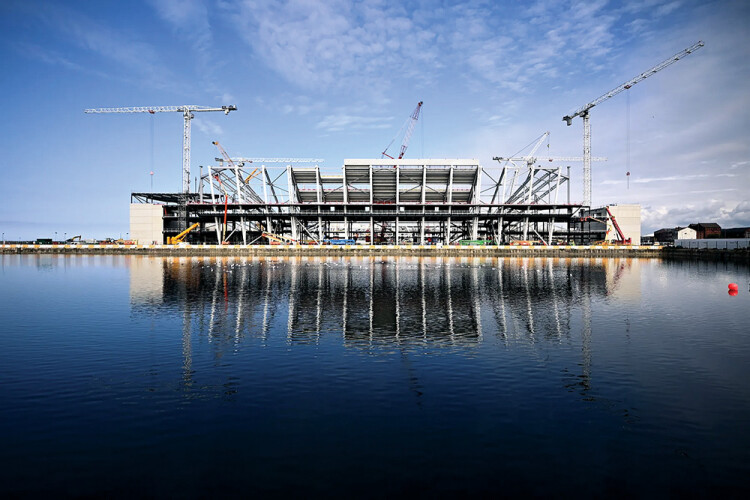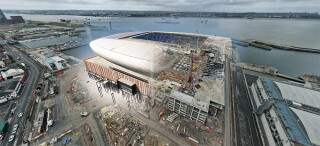All being well, in less than three years’ time Everton Football Club will be moving into a new state-of-the-art stadium, closing the doors on 132 years at Goodison Park.
There is a lot of heritage in this club – it was a founder member of the Football League in 1888 and has spent more seasons in the top flight than any other. No doubt it will be hard for fans to say goodbye to Goodison Park but the designers and the builders of the new stadium are doing their best to deliver a more than worthy successor for the blue half of Liverpool.
Everton’s new stadium is under construction two miles southwest from Stanley Park, across Stanley Road on the Mersey waterfront. The location, at Bramley-Moore Dock, is within Peel L&P’s Liverpool Waters regeneration site.
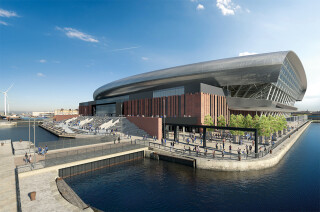
The 52,888-capacity arena has been designed by US architect Dan Meis to reflect both the dockside location and the Everton club heritage. The brick, steel and glass design is said to take inspiration from the local maritime history and warehouse buildings.
Geometric patterns on the brickwork are intended as an echo of the Goodison Park latticework designed by the celebrated stadium architect Archibald Leitch, designer of dozens of football stadia in the first half of the 20th century.
Inside the stadium, the shape of the bowl is structured to put supporters as close to the action as regulations permit – retaining the intensity and intimacy of Goodison Park and giving maximum advantage to the home side before a ball is even kicked.
The stadium is made up of four distinctive stands including a large steep home stand to the south that will house 13,000 home fans on match days. It is this south stand that is expected to determine the match day experience, for fans and players alike.
In a recent episode of the Everton Stadium Podcast (yes, it exists) Meis explained the significance of the south stand to the overall design: “I’ve never had a project where I’ve had – I don’t know – 60,00 consultants and every one was interested in making sure that there was the ability to have the fans right on top of the pitch and as close as possible and as noisy as possible,” he said.
“And making sure we didn’t end up with a big shiny stadium that, no matter how pretty it might be, if it wasn’t affecting and engaging the fans in the way Goodison does, it wasn’t going to be valuable to these fans.”
In February 2020 Laing O’Rourke was named preferred contractor and signed a pre-construction services agreement to develop a detailed design and delivery programme.
As the scheme moved from the concept to the technical phase, Meis was replaced by Pattern (now BDP Pattern), led by Dipesh Patel.
The hope at this stage was that the project would secure planning permission and move to construction before the year was out. But, as we all know, 2020 was not a normal year. It was 2021 before planning permission was secured and on 26th July 2021 Laing O’Rourke took possession of the site.
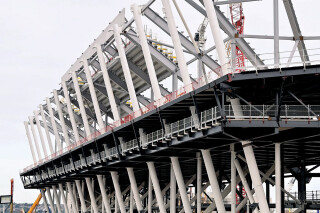
Meis was brought back into the fold by the club in October 2021 once construction had started. His revised remit is to review the technical construction specifications and engage the compliance team ahead of each stage of development to ensure the original design concept remains in place throughout the build. He works under Everton’s stadium development director Colin Chong (a former Laing O’Rourke project leader) and alongside Laing O’Rourke and BDP Pattern.
The first stage of the construction process was land reclamation, filling in the dock to provide a bed for the stadium. Some 480,000 cubic metres of sand was required for the dock infill process, all of which was transported to the site by barge from 20 miles out in the Irish Sea. The enabling works were completed in December 2021.
Meanwhile, piling had begun in October 2021. Some 2,500 concrete piles were sunk by Expanded Piling, a Laing O’Rourke company, to support the stadium structure. They are all 600mm diameter and vary in depth down to 18 metres.
It was not until April 2022 that Laing O’Rourke signed the main works contract with the club. Contract price has not been disclosed but it seems unlikely that the £500m estimate of three years ago has remained unchanged, given recent construction cost inflation.
Nevertheless, the club says the contract that it signed with Laing O’Rourke gave it greater certainty as to the cost of the remaining stages of the project.
The club was clearly mindful of cost overruns on other stadium projects, including Tottenham Hotspur’s £400m initial estimate reaching £1bn eventual cost. Perhaps a key difference is that Spurs employed a construction manager, Mace, and engaged subcontractors itself, leaving much of the project risk with the client.
Building stadiums can be a tricky business. The new Wembley Stadium, built by Multiplex, was late and over-budget. Laing O’Rourke might also be mindful that it was losses on the Cardiff Millennium Stadium that led to the demise of John Laing Construction and enabled Ray O’Rourke to buy it for £1 in 2001.
While we do not know about the money situation, the actually build process in Liverpool Waters appears to be going well.
By August 2022, one year into construction, the four concrete cores in each corner of the stadium had reached their full height ready to support secondary steelwork and, ultimately, the steel roof trusses.
At the same time, Laing O’Rourke had begun putting in the concrete terracing. The first of 1,217 terracing units, which will form the internal bowl lining, was lifted and bolted into place in the lower tier of the north stand on 10th August.
The bespoke, double-stepped terracing units are manufactured by Banagher Precast Concrete in Ireland and delivered by boat to Liverpool docks, a short distance from the project site.
Meanwhile, work continues across all four stands at Everton Stadium, with the two steelwork sections on the north stand edging closer to connecting. Severfield is Laing O’Rourke’s structural steelwork subcontractor.
The club has been meticulous at keeping the public up to speed with progress, posting videos updates at least weekly. This is, after all, the self-styled People’s Project.
Progress reports show that the first precast concrete walls that will make up the first floor have been installed in the east stand, with the entire first floor close to completion in the opposite west stand. In the south stand steelwork is now connected to the structural concrete core in the south west, with additional steelwork also emerging in the southeast corner.
By the end of September the first of the roof trusses was being assembled on site. It is expected that this will be lifted into place on the south stand by November, initially supported by more temporary works built within the stand.
Spaces have been left in the assembly of the concrete terracing units to accommodate these supporting structures.

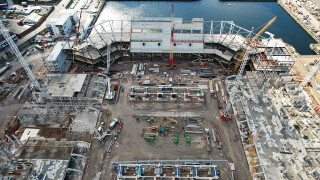
Construction and installation of further trusses will eventually form the framework of the roof across the south and north stands, to be joined later by the roof installations in the west and east stands.
Steel erection and concrete construction take place side by side, and seemingly at a brisk pace. The initial row of concrete raker beams is in place in the west stand, which is now well into the second-floor build.
By October, installation of the concrete terracing units was starting to give internal shape to the north stand. More than half of the upper tier was by now in place, with some of the lower tier also emerging, a month ahead of the expected installation of the initial roof trusses.
In the east stand more concrete raker beams can be seen across the lower length.
Meanwhile, with the south stand now fully connected to the south east core, the final lattice planks are being installed on the top level.
Contributing to the speed of construction on site is the work happening off-site. Before construction began, Laing O’Rourke’s input in the technical design process identified what stadium components could most efficiently be prefabricated elsewhere and transported to site ready for placing by one of the four tower cranes and several crawler cranes (both lattice and telescopic boom) servicing the project.
The resulting system of design for manufacture and assembly (DFMA) entails pre-cast concrete terrace units and external brickwork panels being manufactured under factory conditions and slotted into place on site. These are made by Laing O’Rourke subsidiary Explore Manufacturing in Worksop.
Meanwhile, all mechanical, electrical and plumbing systems in the stadium will also be manufactured off-site by another Laing O’Rourke subsidiary, Crown House Manufacturing in Oldbury. With Explore, Crown House, Expanded Piling and Select Plant embedded in the project, Laing O’Rourke’s involvement is both deep and wide.
The original architect is clearly impressed by what he has seen of the British contractor. After a site visit in August he sat down with Colin Chong to share some thoughts in the
aforementioned podcast.
Dan Meis said: “I think it often gets forgotten that you don’t get to this kind of finished product without that culture going all the way through.
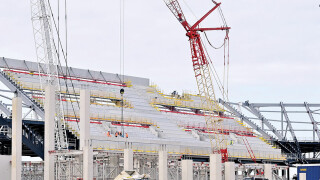
I will tell you, I’ve walked a lot of construction sites in 30 years of doing this and the sophistication and professionalism of what’s going on there is... I have never seen anything like it.
“A lot of the work that is going to get covered up, and people will never see, looks like finished work and that’s all about the sophistication of this builder and the care they’re taking and the culture that comes from the club. It goes all the way through.”
He concluded: “When we were wandering through there, again, I was really struck by [how] every workman knew exactly what they were doing and were just getting on with it, building a really beautiful building.”
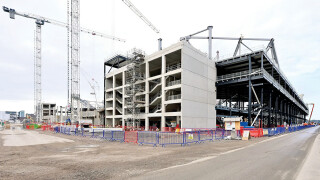
Laing O’Rourke is working to a programme that will see construction completed in time for the club to move in during, or preferably just before, the 2024/25 season.
That will then kickstart a whole new project – demolition of Goodison Park and construction of a 3.4 hectare mixed-use development alongside Stanley Park.
The virtual build
Digital engineer Craig Wallace, part of Laing O’Rourke’s building information modelling team, explains the contribution of BIM to the Everton stadium build
We like to think we have already built Everton Stadium. It’s been built virtually on screen in a simulated environment, and now physically on site.
The real benefit is that this enables us to resolve issues upfront, in a simulated environment, before work begins on-site. That promotes efficiency gains, reduction in risks, leads to programme and cost benefits and provides certainty throughout the life-cycle of the build.
It took some teamwork to pull together and it’s a real collaborative effort, in that our entire supply chain contribute to the model. All of the different disciplines, such as electrical, mechanical, structural and architectural, develop their own 3D model, involving their scope of work, and then share them with us on a collaborative online platform. That provides us with around 1,500 shared model files, which we then combine into a master model for the entire team to use.
From that, the entire project team can work to co-ordinate the build and ensure there are no clashes within the disciplines.
The 3D model shows the width, depth and height. Then, by introducing the dimension of time and linking model elements to the construction programme activities, the 4D model allows the Laing O’Rourke team to visualise the construction sequence and assess potential risks or clashes in the programme, along with opportunities that might not have been seen using more traditional methods.
What you might see in the industry is the model being linked to the programme and that shows the sequencing of the build. In addition to this, we focus on including elements such as coordinating mobile cranes, storage zones, engineering controls, walking routes and more. That really helps to drive what we do on site and how we can coordinate different pieces of work safely. This is our highest value.
Working with our supply chain, we can use the model and embedded data to visually track the progress of the build and then communicate this through dashboard reporting. The model is integral to dictating, with precise detail, the just-in-time delivery slots for tonnes of steelwork and the thousands of concrete wall panels, pillars and beams.
The model is as accurate as it can be, and by coordinating the disciplines we can then increase the accuracy as the design progresses. Out of the models we can then extract the drawings and then they, along with the 3D models, can be used in parallel by the workforce.
Got a story? Email news@theconstructionindex.co.uk

